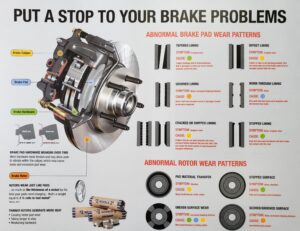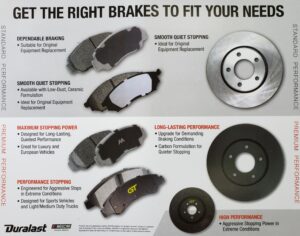Depending on the particular make and model of your vehicle, it will have two or three different types of hydraulic or anti-lock braking systems: disc brakes with brake pads, drum brakes with brake shoes, and emergency brakes. How can tell you tell what’s what?
If you look behind the front wheel hubcap on your car, you will usually see a shiny metal disc inside called a disc rotor. When a driver presses the car’s brake pedal, a hard, heat-resistant brake pad clamps down onto the disc, using friction to slow the car down or stop it. This causes A LOT of heat so brake pads must be made of materials that won’t melt like alloys, ceramics, or composites. With use over time, pads wear down and become thin and will need replacement.
Some cars have disc brakes on front and rear wheels, but many are designed with drum brakes on the rear wheels. Drum brakes come with brakes shoes (instead of pads) which press outwards towards the brake drum to slow your car down. These also create friction/heat and will wear out over time.
Brake pads and shoes both slow or stop your car by working in conjunction with a rotor, which also thins and can wear unevenly over time. Twenty or more years ago, rotors were manufactured differently, which allowed them to be turned on a lathe to smooth them out between replacements; however, today’s performance rotors are not designed for this procedure to be safely used. This is why a complete brake job will include the replacement of rotors, which typically doubles the cost. Although it is always recommended to replace rotors and pads/shoes at the same time, you can usually pass a state safety inspection without replacing the rotors. The brakes might squeak or squeal and not be as quiet or stop as efficiently, so you should consider your options carefully when deciding.
There are also different grades of pads and rotors to choose from. Some pads dust less than others. We recommend Duralast Gold brakes and rotors for the best all-around performance, but economy grades are also available if short-term costs are the most important factor in deciding.


A car’s emergency brake applies the two rear brakes only but in a slower, less forceful way when you activate it.
